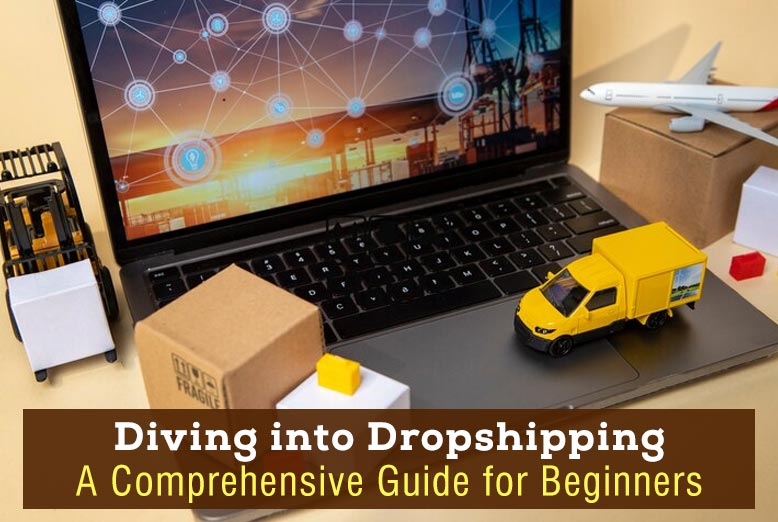Dropshipping has become a buzzword in the e-commerce world, enticing entrepreneurs with promises of low startup costs and flexibility. If you’re new to the concept and eager to explore its potential, this comprehensive guide is designed just for you. We’ll walk you through everything you need to know to start your dropshipping business, from understanding the basics to scaling your operations.
Advantages of Dropshipping
Dropshipping is a retail fulfillment strategy where a store does not maintain its own inventory. Instead, when a product is sold, the store buys it from a third party, such as a wholesaler or manufacturer, who then ships it directly to the customer. This process eliminates the need for the store to handle the product physically.
One of the biggest draws of dropshipping is the low initial investment. You don’t need to purchase inventory upfront or manage a warehouse. This reduces financial risk, making it an attractive option for new entrepreneurs.
Minimal Risk and Inventory Management
Since you don’t buy inventory until you’ve made a sale and have been paid by the customer, there’s little risk involved. You won’t be stuck with unsold products, and you won’t need to manage stock levels, which simplifies your operations significantly.
Flexibility and Scalability
Dropshipping allows you to run your business from anywhere with an internet connection. It also offers scalability. As your business grows, you can handle a high volume of orders without worrying about logistics and storage space.
Global Market Reach
You’re not limited to a local customer base. With dropshipping, you can sell to customers anywhere worldwide, provided your suppliers can ship to those locations.
Disadvantages of Dropshipping
While dropshipping reduces overhead costs, it also typically yields lower profit margins than traditional retail. Your markup is often smaller since you’re purchasing products at retail prices.
Reliance on Suppliers
Your business relies heavily on suppliers for product quality, inventory availability, and shipping times. Any issues on their end can directly impact your customer satisfaction and brand reputation.
Competitive Market
The low barrier to entry means that many others are also trying their hand at dropshipping, making it a highly competitive market. Finding a unique niche and effectively marketing your products is crucial to stand out.
Getting Started with Dropshipping
The first step is to choose what products you want to sell. Conduct market research to find a niche that interests you and has demand but isn’t overly saturated. Use tools like Google Trends, Keyword Planner, and social media to identify trends and consumer interests.
Setting Up Your Business
Ensure you understand the legal requirements to start a business in your area, including registering your business name and obtaining any necessary licenses. Decide on your business structure—sole proprietorship, LLC, etc.—and consider consulting with a legal professional.
Selecting a Dropshipping Platform
Several platforms, such as Shopify, WooCommerce, and BigCommerce, can help you build your online store. Each has its own set of features, so choose one that best suits your needs and budget.
Finding Reliable Suppliers
Look for suppliers who offer high-quality products, competitive pricing, and reliable shipping. Check their reviews and ratings, request samples to assess product quality, and ensure they have a good communication and reliability track record.
Popular Dropshipping Supplier Directories
Directories like AliExpress, SaleHoo, and Worldwide Brands can help you find reputable suppliers. These platforms vet suppliers, making it easier for you to find reliable partners.
Building Relationships with Suppliers
Establishing a good relationship with your suppliers is crucial. Communicate clearly, pay on time, and be respectful of their processes and timelines. Building a strong relationship can lead to better pricing, faster shipping, and priority support.
Avoiding Scams and Fraudulent Suppliers
Always do your due diligence before partnering with a supplier. Look out for red flags such as unprofessional websites, lack of contact information, and overly aggressive sales tactics. Use trusted platforms and read reviews from other retailers.
Setting Up Your Online Store
Select an e-commerce platform that aligns with your business needs. Shopify is popular for its ease of use and extensive app ecosystem. WooCommerce is a good option if you prefer a more customizable, open-source solution.
Designing Your Store
Your store’s design should be user-friendly and visually appealing. Choose a theme that reflects your brand’s identity and ensures a seamless shopping experience. Pay attention to navigation, mobile responsiveness, and loading times.
Adding Products to Your Store
When listing products, use high-quality images and write detailed, engaging descriptions. Set competitive pricing while considering your profit margins. Optimize product listings for SEO to improve visibility in search engines.
Payment Gateways and Checkout Process
Offer multiple payment options to cater to different customer preferences. Ensure your checkout process is smooth and secure to build trust and reduce cart abandonment.
Managing Orders and Customer Service
Establish a streamlined order processing workflow. Ensure orders are forwarded to suppliers promptly, and keep customers informed about their order status through automated emails.
Handling Returns and Refunds
Set clear return and refund policies to manage customer expectations. Work closely with your suppliers to handle returns efficiently and maintain customer satisfaction.
Providing Excellent Customer Service
Use communication and support tools to offer excellent customer service. Respond to inquiries promptly and resolve issues efficiently. Good customer service can lead to positive reviews and repeat business.
Dealing with Negative Reviews
Address negative reviews professionally and constructively. Apologize for any issues, offer solutions, and use the feedback to improve your operations.
Considering all these aspects, you can also explore blind dropshipping as an innovative approach to managing customer satisfaction without revealing your suppliers.
Conclusion
Dropshipping offers new entrepreneurs an exciting opportunity to start an online business with minimal investment. You can build a successful and scalable business by understanding the intricacies of dropshipping, choosing reliable suppliers, and implementing effective marketing strategies. Remember, patience and persistence are key. Start your dropshipping journey today and turn your entrepreneurial dreams into reality.
Also Read: Why The Look and Feel of Your Online Business Links Matters




















